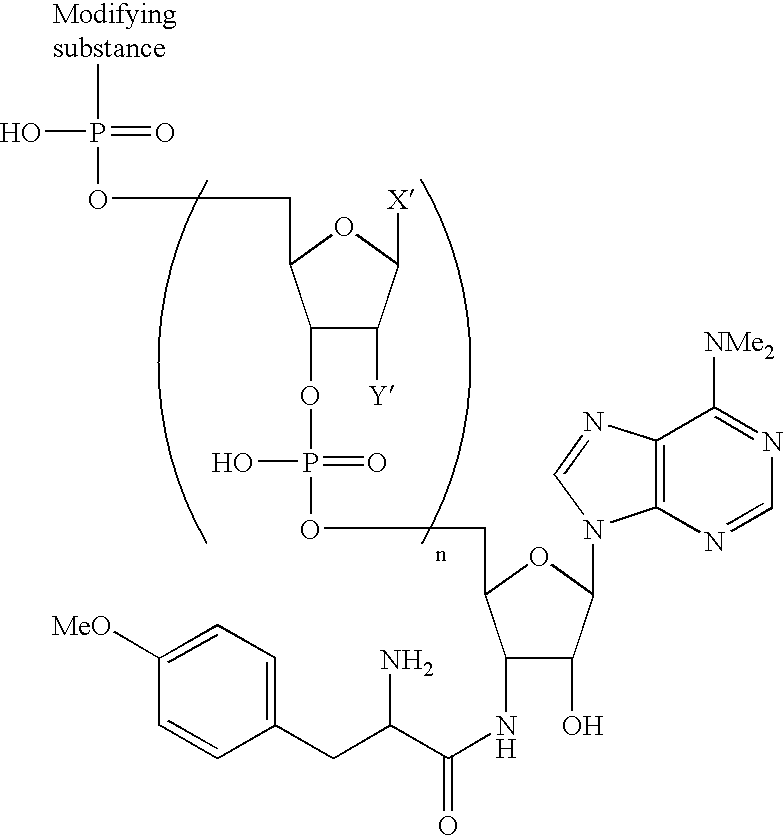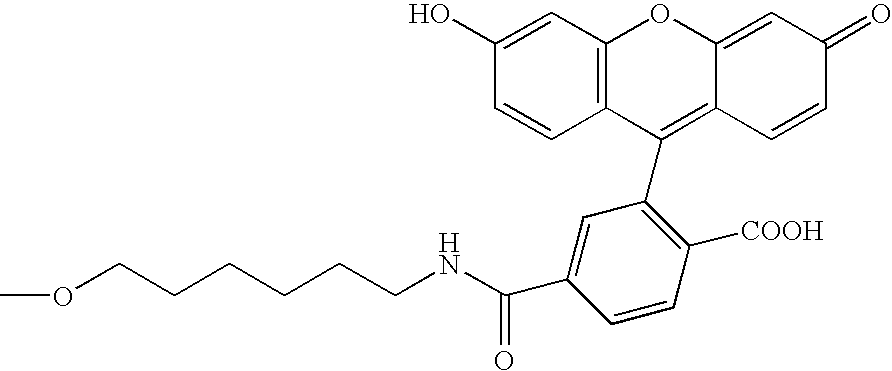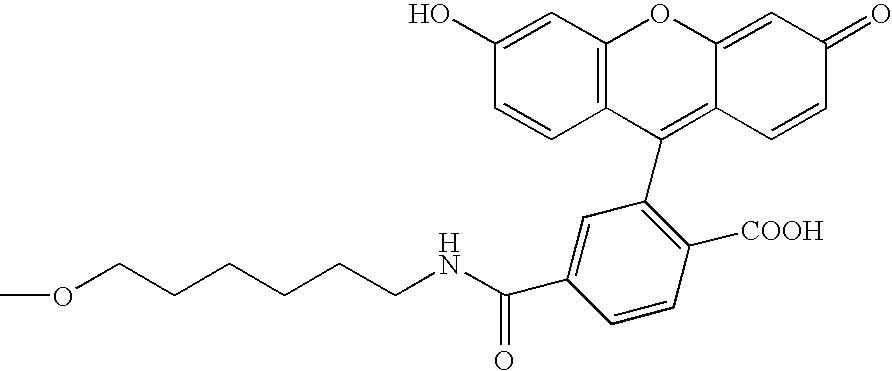Recombinant template used for producing a carboxy-terminal modified protien and a method of producing a carboxy-terminal modified protein
- Summary
- Abstract
- Description
- Claims
- Application Information
AI Technical Summary
Benefits of technology
Problems solved by technology
Method used
Image
Examples
example 1
Increase of Efficiency of Fluorescence Modification of Protein and Detection of Protein Interaction by Fluorescence Cross-correlation Spectroscopy
[0124]The c-Fos and c-Jun proteins, which are cancer gene products, form a dimer, and recognize and bind to DNA having a particular nucleotide sequence to function as a transcription factor. By using this system as a model, the c-Fos and c-Jun proteins were modified with several types of fluorescent dyes to detect interactions between proteins and between a protein and DNA by fluorescence cross-correlation spectroscopy.
1) Synthesis of Modifying Agents
[0125]Modifying agents containing a puromycin residue were synthesized by using a method outlined in FIG. 2 (Solid Phase Method 1) or FIG. 3 (Solid Phase Method 2). In the synthesis, Compound 1 was synthesized by the method reported by Ikeda et al. (Ikeda, S. et al., Tetrahedron Lett. 39, 5975–5978, 1998). Nucleotide phosphoramidites, modifying substance-phosphoramidites and Compound 2 were pu...
example 2
Translation Template and Fluorescence Modification Efficiency in Wheat Germ Cell-free Translation System
[0173]A sequence of a vector or plasmid to which mouse-derived c-jun or c-fos was incorporated, or a DNA template containing such a sequence was amplified by PCR using TaKaRa Ex Taq (Takara Shuzo) and purified by using QIAquick PCR Purification Kit (QIAGEN). As the template for PCR, c-jun[pSPAM], c-fos[pSPAM] and c-jun[F] (the nucleotide sequences are shown in SEQ ID NOS: 10–12, respectively) were used. As the primers, SP6F and 5′SP6-O29 (the nucleotide sequences are shown in SEQ ID NOS: 13 and 14, respectively) were used as Primer 1 (forward primer), and JunHis, JunHisA, FosHis, FosHisA, JunFlagA, 3′HisA and 3′FlagA (the nucleotide sequences are shown in SEQ ID NOS: 15–21, respectively) were used as Primer 2 (reverse primer). The translation templates (DNA templates) were obtained by the above method. Each template was transcribed (37° C., 2 hours) by using RiboMAX™ Large Scale R...
example 3
Modification of C-terminal of Protein with Biotin and Immobilization to Streptavidin Membrane
[0176]Preparation, transcription and translation of DNA coding for the mouse c-Jun protein and purification of the c-Jun protein were performed in the same manner as in Example 1.
[0177]5 μL of the c-Jun protein of which C-terminal was modified with a modifying agent having biotin and a fluorescent dye (TAMRA) in the same molecule (Modifying agent 20) or a modifying agent having only a fluorescent dye (TAMRA) (Modifying agent 19) was spotted on a streptavidin membrane (SAM Biotin Capture Membrane, Promega), and after 1 minute, the membrane was washed with 50 mL of 2 M NaCl solution 4 times and with distilled water twice. Then, fluorescence of TAMRA was detected at 532 nm by using an image analyzer (Molecular Imager FX, Bio-Rad). As a result, as shown in FIG. 8, it was found that the c-Jun protein modified at its C-terminal with the modifying agent having biotin and fluorescent dye in the same...
PUM
| Property | Measurement | Unit |
|---|---|---|
| Fluorescence | aaaaa | aaaaa |
| Radioactivity | aaaaa | aaaaa |
Abstract
Description
Claims
Application Information
 Login to View More
Login to View More - R&D
- Intellectual Property
- Life Sciences
- Materials
- Tech Scout
- Unparalleled Data Quality
- Higher Quality Content
- 60% Fewer Hallucinations
Browse by: Latest US Patents, China's latest patents, Technical Efficacy Thesaurus, Application Domain, Technology Topic, Popular Technical Reports.
© 2025 PatSnap. All rights reserved.Legal|Privacy policy|Modern Slavery Act Transparency Statement|Sitemap|About US| Contact US: help@patsnap.com



